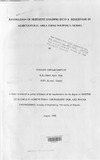| dc.description.abstract | The study aims at using a newly developed process-based model, WEPP(95.7), to
estimate sediment loads in an agricultural reservoir in a semi arid area using easily available
data, and to identify conservation strategies that could be used to reduce the rate of
reservoir sedimentation from the catchment. The study was carried out at Ndaragwiti
Reservoir and its catchment in the semi arid area of Laikipia District.
The catchment is located in the Sipili location of Ng'arua Division. The catchment
covers an area of approximately 2.7 km2 and is about 1.0 km north-west of Sipili township.
The area has a mean annual rainfall of 699 mm, a maximum temperature ranging between
24°C and 2rC and a minimum temperature ranging between 7°C and IO°C. The whole
catchment was under cultivation.
The reservoir had a surface area of about 1.9 ha with a mean depth of 1.2 m, and
the full capacity of the reservoir was 34,000 m3.
In accordance to the WEPP(95. 7) model requirements, the catchment was divided
into five main blocks, and subdivided into twenty two plots, or hillslopes.
The WEPP(95. 7) model was run under two categories - Hillslope WEPP(95. 7)
model and Watershed WEPP(95. 7) model. Some soil physical and chemical characteristics,
slope characteristics, climate characteristics and plant/management characteristics were
determined for each hillslope thus being necessary to run the Hillslope WEPP(95. 7) model
for the purpose of estimating soil loss from each hill slope. The output of the Hillslope
WEPP(95.7) model for each hillslope together with the channel characteristics in terms of
soil, slope, climate and plant/management were determined as well as the impoundment
characteristics to run the Watershed WEPP(95. 7) model.
Under the existing conditions of available data, the WEPP(95.7) model estimated
the annual total sediment yield of about 1892 tonnes. This gave an average sedimentation
rate of 700 t/km2/yr. The WEPP(95.7) estimate was compared to the measurement made
from geodetic survey on the reservoir and gave a relative difference of about 40 percent
less.
Even though, the WEPP(95.7) model underestimated the sediment yield by about
40 percent, it was considered to give a fair estimation because the sediment contributed by
wind,the roads on the catchment and the unconsolidated embankment of the reservoir and the channels were not accounted for by the WEPP(95.7) model.
A comparison was made of soil loss simulated using WEPP(95. 7) model on
randomly selected ten plots of different sizes and slopes on the catchment under the
following treatments: the current hand hoeing, and maize and beans intercropping
(HOCOBE); tractor ploughing, and maize and bean intercropping (COBEAN); tractor
ploughing and only maize grown (CNTCORN); and tractor ploughing and only beans
grown (CNTBEAN). The soil loss reduction of HOCOBE and COBEAN, HOCOBE and
CNTCORN, and HOCOBE and CNTBEAN ranged between 27- 47 percent, 16 - 29 percent
and 12 - 25 percent respectively.
These figures indicated that there could be a drastic soil loss reduction if the farmers
adopted tractor ploughing as the farm operation method. | en |

